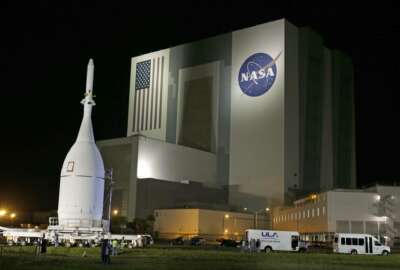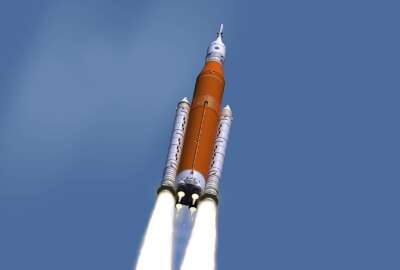
And old idea gets a fresh look: A nuclear-powered space ship
The idea of a nuclear-powered spacecraft goes back decades. Now it may become reality. The Defense Advanced Research Projects Agency (DARPA) and NASA are teaming up...
The idea of a nuclear-powered spacecraft goes back decades. Now it may become reality. The Defense Advanced Research Projects Agency (DARPA) and NASA are teaming up on a demonstration project. They want to see if a nuclear rocket engine could power flight to Mars. To talk about the project, the Federal Drive with Tom Temin was joined by Anthony Calomino, NASA’s Materials and Structures Engineer.
Interview transcript:
Tom Temin
The idea of nuclear powered spacecraft goes back decades almost science fiction days. Now it might become a reality. The Defense Advanced Research Projects Agency, DARPA, and NASA are teaming up on a demonstration project. They want to see if a nuclear rocket engine could power flight to Mars. Joining me with the details NASA program manager, Dr. Anthony Calomino. Dr. Calomino, good to have you with us.Anthony Calomino
Good morning, Tom. And thank you for inviting me on.Tom Temin
So we’re talking about nuclear for propulsion, and not nuclear to like, keep the astronauts alive with electricity, and to run the microwave oven inside there.Anthony Calomino
So the [Demonstration Rocket for Agile Cislunar Operations (DRACO)] mission, that we’re partnering with DARPA on, is actually a propulsion system. That really is all that it will do, is provide thrust to the vehicle.Tom Temin
And is this thrust that would take it out of Earth into Space? Or would it kick in once the vehicle is in Space?Anthony Calomino
So we would actually place the vehicle itself, the nuclear thermal rocket, we would actually place it into orbit around Earth using chemical systems, traditional chemical systems. And then once it is in orbit, a safe orbit around Earth thousands of kilometers away, that’s when we would conduct the experiment, the nuclear part.Tom Temin
Because the levels of thrust needed to maneuver in Space are infinitesimal, compared to what it takes to get up and out into Space from Earth.Anthony Calomino
It certainly is a small fraction. Once you’re in Space, you need a small fraction of the force that it took actually to get the hardware and the mass into space to move around, yes.Tom Temin
And before we get into some of the details in between for this craft to come back from Mars, I don’t know what the gravitational pull on Mars is, but would this be able to get out of Mars and back into reentry here?Anthony Calomino
So I just want to make clear, the mission that we’re talking about with DRACO will just be an in-space-near-Earth demonstration. It wouldn’t be anything, what we would call as a operational vehicle, it would just be a proof of demonstration of the technology, itself. When we get to an operational vehicle, something that we would want to use for Mars. The nice thing about [Methane Thermal Properties (MTP)] is it provides us high thrust, so we can generate up to anywhere from 25,000 up to 75,000 pounds of thrust, from that engine. And that’s the kind of force that you would need to leave Earth. We call it Earth Departure. And get on to a trajectory that would give you the sufficient philosophy or energy to get to Mars.Tom Temin
And you’ve mentioned the DRACO project with DARPA, that’s Demonstration Rocket for Agile Cislunar Operations. Cislunar meaning what?Anthony Calomino
Cislunar means the space between Earth and the Moon, is really the way that you could think of it. It extends a little bit beyond the moon, but it is certainly the space that is around Earth and the Moon.Tom Temin
And just in layman’s terms, how would this rocket engine work? Because you think of nuclear power as generating heat, and then that heats up water to produce steam or something like that. How would this work? You’ve got a nuclear reactor, then what?Anthony Calomino
It uses some of those very similar principles, that you just spoke to. It’s actually is an incredibly simple system. It is the reactor, which is used as a key to or thermal energy source, so it heats up hydrogen propellant that flows through it. And then we use the heated hydrogen propellant through an exhaust nozzle to move the vehicle forward. So the reactor is really the energy source for propulsion.Tom Temin
And it would heat up hydrogen and shoot it out a nozzle?Anthony Calomino
Yes, and push it out a nozzle.Tom Temin
What are the chief difficulties of this, is it’s simply that people worry what could happen with a nuclear source if something went wrong with it, and then you’d have a bad problem?Anthony Calomino
So we could talk about the safety of of the nuclear aspects to the design. We actually are using quite a bit of knowledge, that’s been gained with terrestrial systems on how to manage fuel and how to manage the temperatures of those fuels and keep the system safe. And we’re going to implement that, in these systems as well. The real challenge for the [Network Time Protocol (NTP)] system is the reactor, but it’s not the nuclear aspects of the reactor so much, as it is the high temperatures that reactor is going to operate at. So eventually, NASA would want to have a reactor that can operate at 2700 or 2800 degrees Celsius. And so that puts a lot of strain and stress on the materials. And that becomes the big challenges, is picking the right materials that work for that application and making sure that they survive the function.Tom Temin
We’re speaking with Dr. Anthony Calomino, he’s a program manager and a materials and structures engineer at NASA Headquarters. Is there lessons learned for this from say, the Navy’s experience in nuclear submarines?Anthony Calomino
Lessons learned with, it’s not just the Navy reactors, it’s all of the reactors, but certainly the Navy has a lot of safety protocols and safety procedures in the way that they operate those nuclear reactors. And we do have associations and subject matter experts that we’ve talked to and work with on that to make certain that we implement their practices where it makes sense. And we utilize their lessons learned on base systems.Tom Temin
Of course, they’re surrounded by cold water that can be, I guess, pumped in to cool things off if need be, not the case in cislunar space.Anthony Calomino
Yeah, not the case in cislunar space. But one nice thing about being in cislunar space is that you’re outside of the biosphere of Earth. And again, these systems are going to be very safe, we have no reason to believe that there would be a problem. But the one nice thing about it is that the consequences of something should happen is very, very small for Earth, itself.Tom Temin
Right. And of course, you’ll be testing it without anybody aboard.Anthony Calomino
Right. The first few instances of this, there will be autonomous vehicles that will be tested without any life form on onboard.Tom Temin
And tell us about the programmatic aspects of this, what is DARPA bringing to it? What is NASA bringing to it, and when will we see something try it out?Anthony Calomino
So NASA has responsibilities is really the key thing that that we have the strong technical interest in, which is the engine itself. The the reactor design, the reactor operation, and all of the turbo machinery that needs to wrap around that to make it an integrated engine. So NASA will be taking responsibility to manage and fund that activity, that would really be the core of what we would want to use for some of our missions. DARPA will be taking the responsibility for the overall integrated vehicle that would demonstrate it, there’s crowd fluids that need to be designed and placed into the vehicle. I actually, the mission ConOps, the launch requirements to safely launch it from Earth. And those would be the responsibilities for DARPA on the mission.Tom Temin
So it will go up, this engine will have, some kind of a simulated craft, not simulated, but a model type of craft that it’s attached to. And how will that whole thing get up into Space in the first place?Anthony Calomino
So the entire vehicle, space vehicle, will actually be assembled on Earth. It’s relatively small by launch payload standards, relatively low mass system, those aren’t really constraints, in terms of what we’re doing. So we would launch an integrated system, that would be ready to be, essentially turned on and operated. It would include all the crowd fluid tanks, all of the avionics, all the controls, including the engine on it, to demonstrate.Tom Temin
And this is something, I’m thinking minivan size type of thing?Anthony Calomino
Yeah, I think that’s a fair approximation of what we would consider to be the size of the system.Tom Temin
And of course, you’ll be able to measure all of its activities and parameters by telemetrics. Will it come back? Or will it just sort of burn out?Anthony Calomino
No. So on the first, we will have it fully instrumented, and we will have a robust palette of information that will be generated from the test. It will be recorded, obviously, digitally recorded. It will be transmitted back to Earth, we will be watching the operation of it real-time. When the demonstration mission is over, the system will be left in a near circular orbit thousands of kilometers away from Earth. And it will be safe there orbiting the Earth, for as long as it has, or represents any radiation concern to Earth, itself. It would stay out there.Tom Temin
And when is the planned launch of this thing?Anthony Calomino
Right now, we believe that the launch will happen as early as calendar year 27. It’s a very aggressive schedule that we’re looking to conduct this mission on. And so, we’re really quite anxious to get started.Tom Temin
And will NASA be fabricating and crafting in this engine itself? Or do you use contractors that have knowledge of nuclear systems?Anthony Calomino
So NASA, we’re relying on an industry prime. And actually, NASA will actually be using some of the investments, that DARPA has made up to this point, to get some of the industry engaged on this. But NASA and DARPA have both had engagements with industry over the past few years on this. So there’s a good alignment between both communities. We’re pretty well linked, in terms of how we would look at that design to go and and how we would build it.Tom Temin
Right. So we won’t see it overhead mixing in with all the mysterious balloons or anything in the next few months. This is years out yet.Anthony Calomino
We’ll be very clear about what it is that we’re launching and what we’re testing.
Copyright © 2025 Federal News Network. All rights reserved. This website is not intended for users located within the European Economic Area.
Tom Temin is host of the Federal Drive and has been providing insight on federal technology and management issues for more than 30 years.
Follow @tteminWFED




